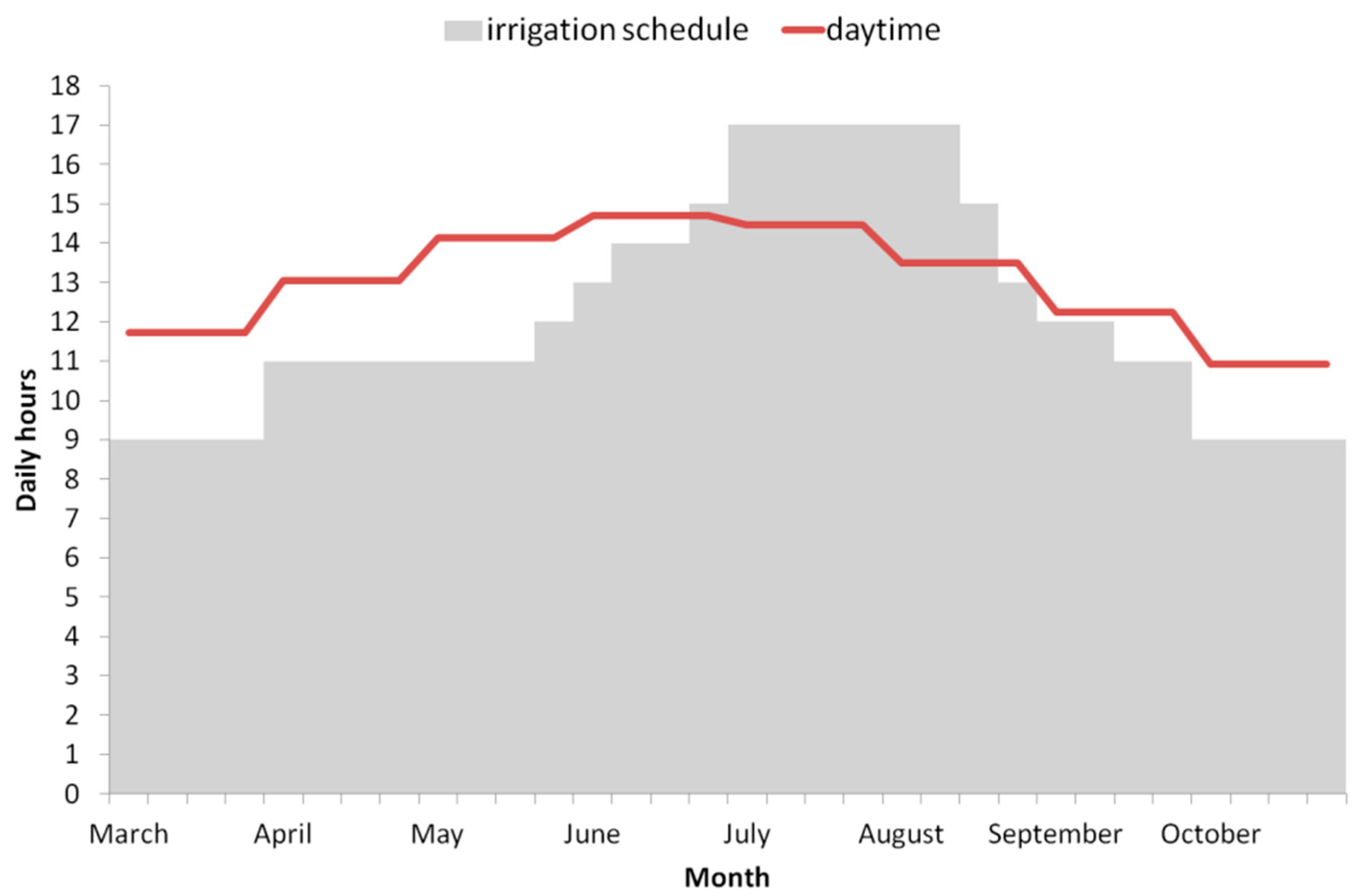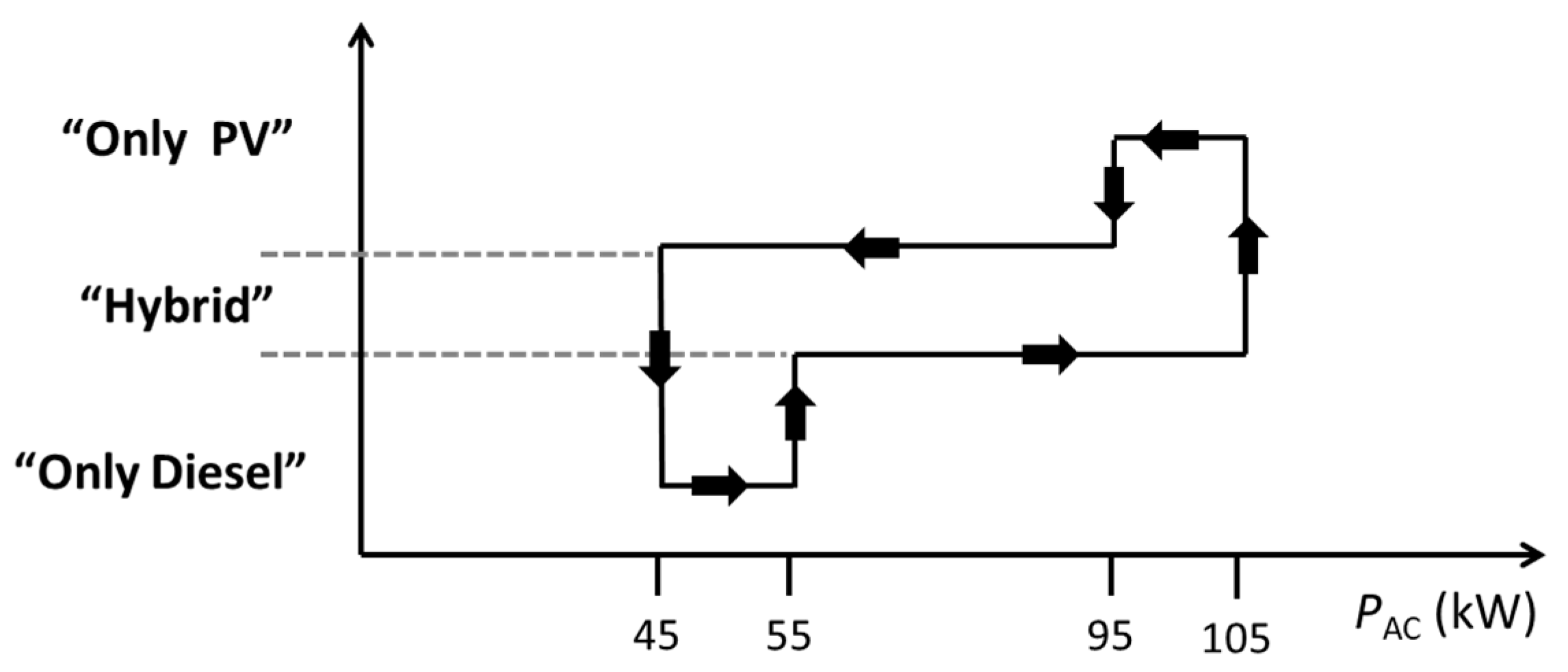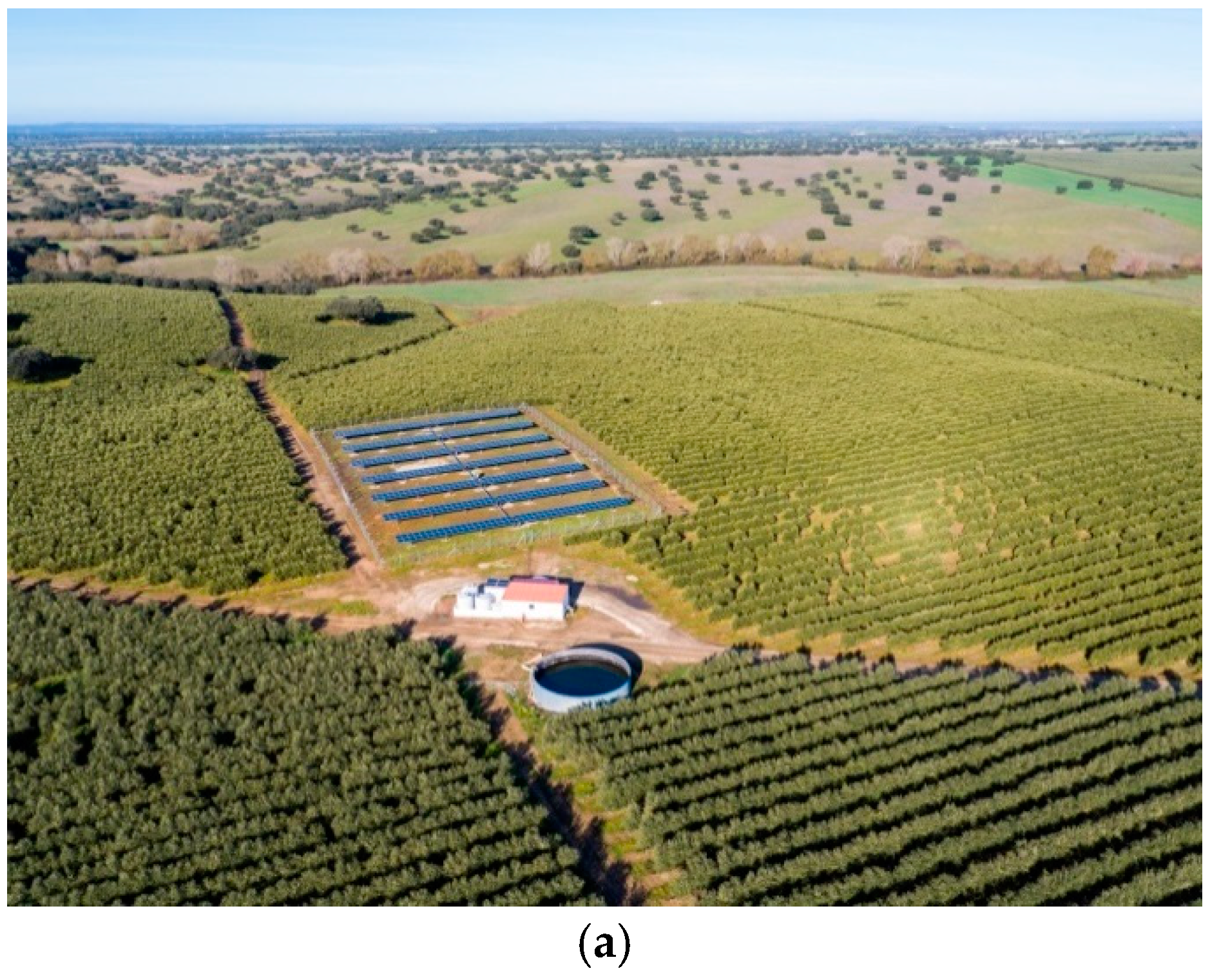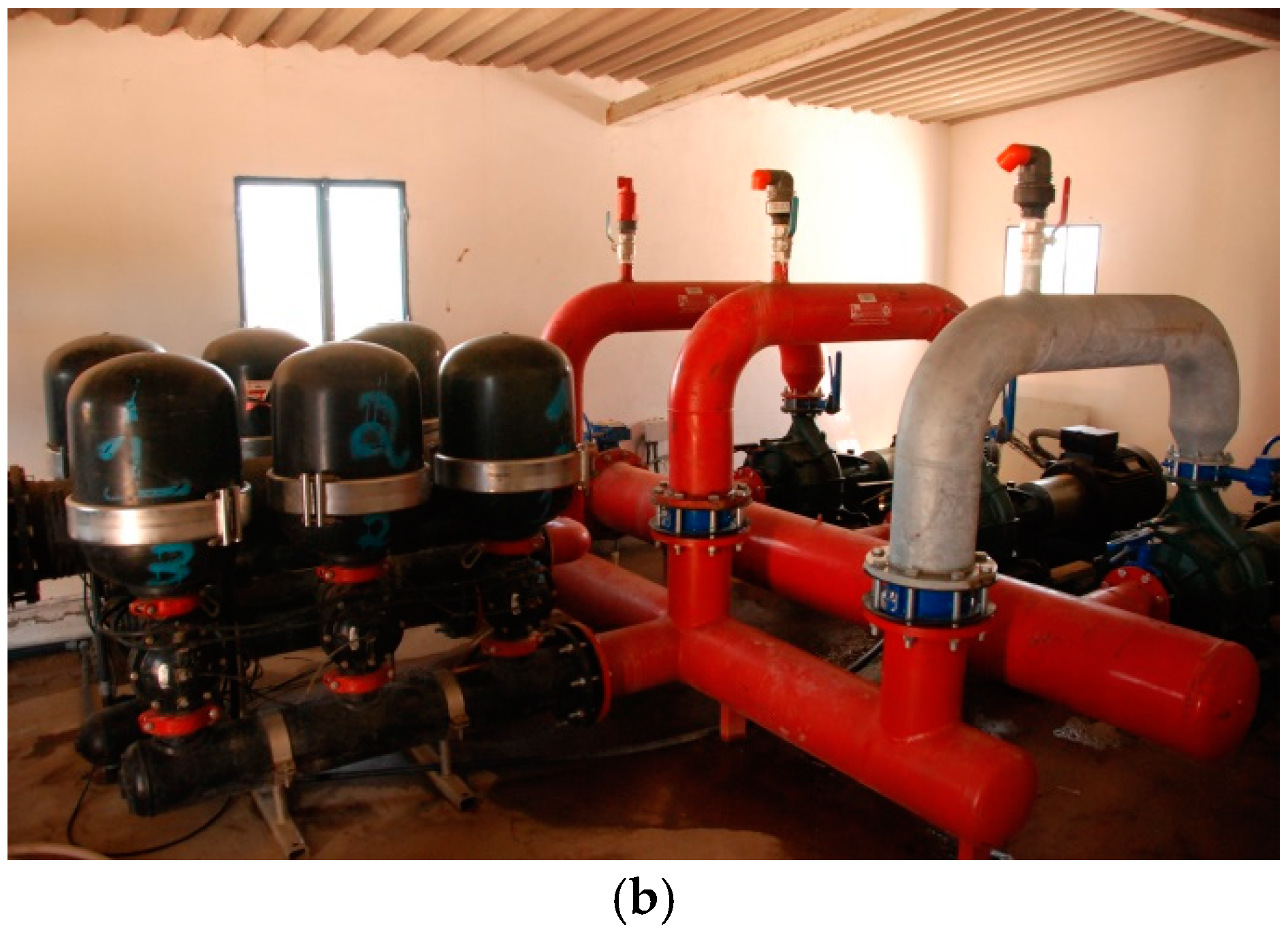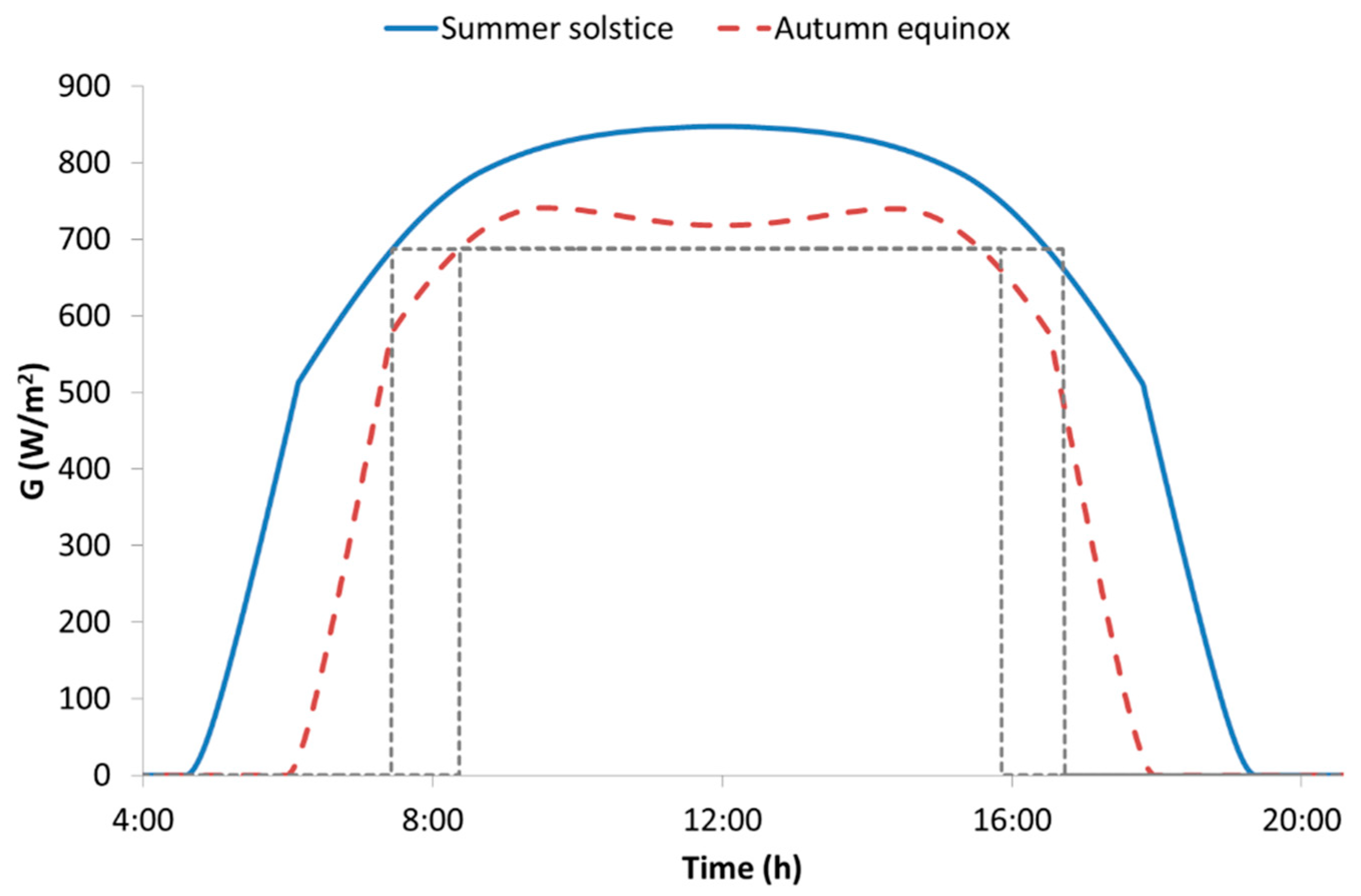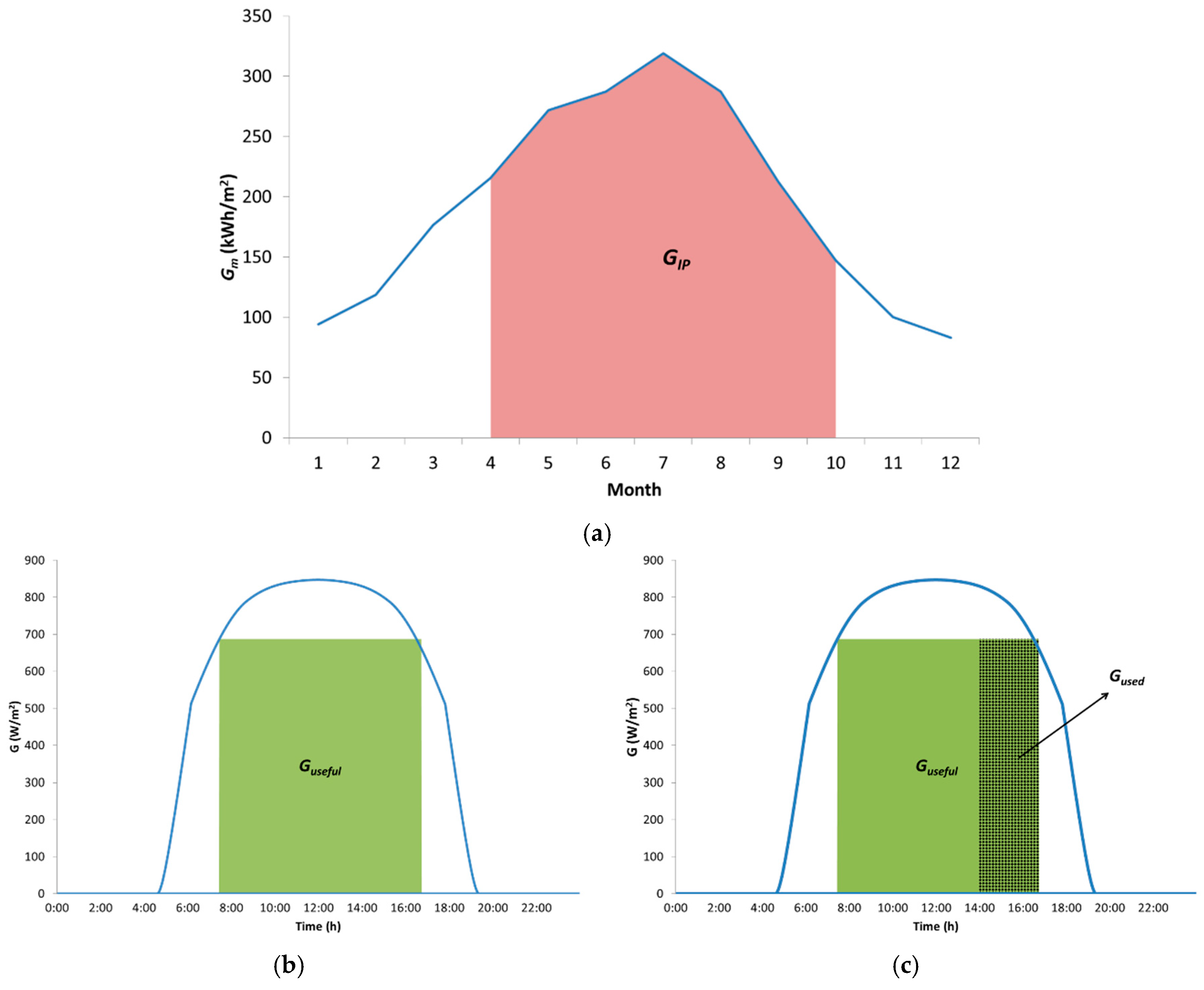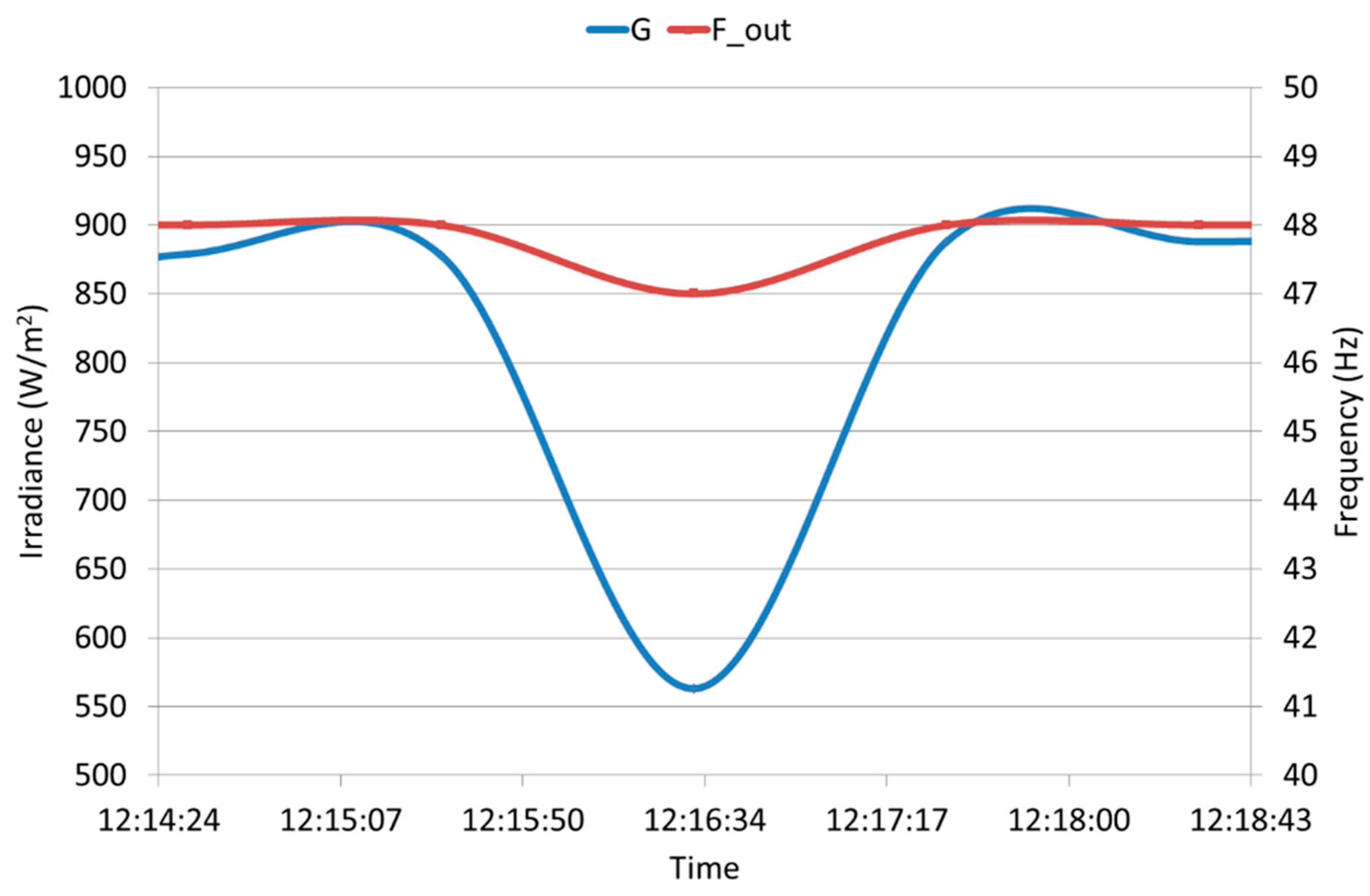1. Introduction
Diesel generation typically supplies electricity at about 3.5 kWh per liter, which represents a fuel consumption cost of around 0.3 €/kWh. Meanwhile, photovoltaic (PV) electricity prices have declined below 0.1 €/kWh [
1]. Thus, PV hybridization with pre-existing diesel-based irrigation systems is becoming increasingly attractive, as pointed out by several authors in [
2,
3,
4,
5].
The history of PV water pumping to provide drinking water or to irrigate starts in 1973, when Dominique Campana coordinated the installation of the first one in Corsica, France, including a Guinard DC pump fed by Philips PV modules [
6,
7]. However, from this first experience till now, the PV pumping technology has been limited to less than 40 kWp of peak power (the power at standard test conditions, STC [
8]). For example, the most important PV pumping programs in the 70’s were reviewed by Newkirk [
9], who indicated that the biggest one was a 25 kWp in the USA. Between 1979 and 1981, the United Nations Development Program implemented a pilot project to test and evaluate PV pumping systems, with powers ranging from 100 Wp to 300 Wp, used in small-scale irrigation systems in Mali, the Philippines, and Sudan [
10]. Between 1977 and 1990, around 200 systems were installed in Mali, with a total installed power of 220 kWp [
7,
11]. In the early 1990s, the European Commission launched the Solar Regional Program (PRS) in the Sahel countries to improve water access for the population (both in quantity and quality), as well as improving their economic conditions through the irrigation of vegetables and fruit trees [
11,
12]. This project allowed the installation of 1040 systems, with a total PV power of 1.3 MWp [
11,
12], being the bigger system of 3.9 kWp [
13]. This program was the first in the PV pumping field that included technical specifications and quality control procedures [
11]. Also, in the early 1990s, the German Cooperation Agency (GTZ) developed the “PVP Program”, with the objective of demonstrating the maturity of the technology and its real costs. The program installed 90 PV pumping systems, with a total power of 180 kWp, in Argentina, Brazil, Indonesia, Jordan, the Philippines, Tunisia, and Zimbabwe (according to Anhalt, cited in [
11]).
During the 1990s and the beginning of this century, some other national projects arose in India [
7], Morocco [
7,
14], Brazil [
15], and Mexico [
16]. In the case of Morocco, the biggest system had 5.3 kWp [
17]. In Brazil, 2500 systems were installed, with an average power of 280 Wp [
15]. Finally, in Mexico, the maximum power of the system reported was 848 Wp [
16]. The technological evolution in these programs went from dedicated inverters and centrifugal pumps specifically dedicated to PV applications to both standard frequency converters and AC centrifugal pumps [
18,
19]. This contributed to an increase in the reliability and efficiency of the systems due to the use of well-proven components. Since this equipment was extensively used in industrial applications, a decrease in price was also verified and the availability of spare parts and the access to maintenance tasks significantly improved.
In the last few years, a large number of national and international programs were launched to promote PV water pumping systems for irrigation. For example, the 2016 IRENA (International Renewable Energy Agency) report on Solar Pumping for Irrigation [
5] mentions three of them: India intends to install 100,000 PV pumps by 2020, Morocco 100,000 by 2022, and Bangladesh 50,000 by 2025. For instance, in India, the fuel prices have increased by more than 250% since 2000, which has led the Government of India to support and promote solar pumping systems [
20]. In Bangladesh, according to [
21], the government installed 10,000 PV pumping systems until 2016. Furthermore, in Chile, 1480 systems with PV sizes from 1 kW to 3 kW were installed in 2013–2014 [
22]. An international big project also deserves attention: Powering Agriculture: An Energy Grand Challenge for Development [
23]. It is a project devoted to all kinds of support in what concerns the energy-water-food nexus in developing countries and it includes, but it is not limited to, low-power PV water pumping systems for irrigation.
Lastly, it is important to underline that the last reviews published about PV water pumping systems (including PV water pumping systems for irrigation) are still reporting only small-power systems [
24,
25,
26,
27]. For example, the largest system presented in the review of Wazed was 11 kWp [
26], while the largest one in the Sontake review was 15 kWp [
27]. A review of the current commercial products (see for example [
28]) shows that the market is offering PV irrigation systems under 40 kWp.
The limitation of power in the current state of the art products is due to two main technical barriers identified by the European Innovation Partnerships on Water (EIP-Water) [
29]. On the one hand, the quick intermittence of PV power due to the passing of clouds (up to 80% of PV power variation in one minute [
30]) can translate into control instabilities, leading to a sudden motor shutdown, encompassing the water hammer and AC overvoltage that seriously threatens the integrity of both the hydraulic and electric components [
31]. On the other hand, PV production and water needs must match as far as possible in time [
32,
33] to maximize economic returns [
34]. Moreover, where drip irrigation is concerned, the hydraulic pressure, and hence the electric power delivered to the pump, must be kept essentially constant [
35].
The main novelty of this paper is that we have developed solutions for these two technical barriers and have applied them to the design and implementation of a large-power hybrid PV-diesel irrigation system that has been analysed during two years of operation in the framework of a European project [
36]. Instabilities due to PV power intermittences have been addressed by specific control algorithms without the need of batteries [
37], and the match between PV production and water needs for irrigation has been solved by using one-horizontal axis trackers. To ensure economic feasibility, batteries have been disregarded [
38]. These new solutions have allowed an increase of the range of powers to the ones that satisfy the irrigation needs of farmers, co-operatives, irrigator communities, and agro-industries. In fact, the hybrid PV-diesel irrigation system presented in this paper has a 140 kWp PV generator, which was the power required for the drip irrigation of 195 ha of olive trees in Alter do Chão (Portugal) belonging to the company ELAIA, which is part of the Sovena Group, one of the biggest producers of olive oil in the world.
The second novelty of this paper is that the design has paid attention to the problem of integrating the novelty of PV into the pre-existing irrigation system, including the diesel generator. The pre-existing network requires up to 17 h to irrigate all the sectors of the farm due to the diameter of the distribution pipes, so irrigation with just the PV generator is impossible and hybridization with the existing diesel generator is required. A specific configuration based on hydraulic hybridization has been developed to maximize the use of PV electricity [
39].
Furthermore, a third novelty is that, apart from the technical quality of the components, the performance of the PV system is not only affected by intrinsic-to-design characteristics (for example, pumping at a given head requires the irradiance to be higher than a certain threshold, which implies corresponding irradiation losses), but also by circumstances external to the system. In fact, the PV system only works when water is both available at the source and required by the plants [
40]. The corresponding useful period (and, again, corresponding irradiation losses) substantially varies from case to case and from year to year. Therefore, to evaluate the performance of PV irrigation systems and, in particular, the performance of the system presented, new performance indices for distinguishing between the PV system quality and PV system use have been developed.
Finally, the economic feasibility of the new large-power hybrid PV-diesel irrigation system has been analysed based on actual operation data to determine whether the hypothesis that large PV power systems can be more competitive in the market than both small ones and alternative power sources can be confirmed.
This paper is structured as follows:
Section 2 includes a description of the Alter do Chão irrigation system, both the pre-existing only-diesel system and the current hybrid PV-diesel system.
Section 3 is dedicated to the presentation of performance indices for hybrid PV systems.
Section 4 is about the in-the-field performance of the system during the irrigation campaigns of 2017 and 2018.
Section 5 presents the study of the economic feasibility and the conclusions are summarized in
Section 6.
3. Performance Indices for Hybrid PV-Diesel Systems
This section proposes a set of indices for qualifying the design and operation of a general PV-diesel hybrid system. First, the energy balance is described in
Figure 8 and quantified by means of three ratios defining the PV share (
PVS), the PV performance (
PR, the index most used by the PV community, [
53]), and the hydraulic efficiency (
), respectively. The following equations apply:
where
EPV and
Ed are the energy supplied by the PV generator and the diesel generator, respectively,
EHyd is the hydraulic energy, and
ηHyd is the efficiency of the hydraulic system. The following comments apply.
On the one hand, from the PV engineering point of view, the two operational modes involving diesel are different. In the case of systems designed for being powered mainly by PV during the daytime, the “Only Diesel” mode becomes relevant mainly at night-time and is somewhat out of PV’s concerns. On the other hand, the “Hybrid” mode only occurs during daytime and is directly related to the design of the PV system. Therefore, it is interesting to distinguish between a
PVS characteristic of the overall operation, which is of interest to the user, and a
PVSH characteristic solely to the “Hybrid” mode. That can be easily done by defining a hybrid diesel ratio,
HDR, as:
where
and
are the energy supplied by the diesel generator in the “Hybrid” and “Only Diesel” operation modes, respectively. Then, Equation (4) can be rewritten as:
and:
Furthermore, the
PR is widely used in general PV environments and provides an indication of both the technical quality of the PV system’s equipment and the efficient use of the available irradiation. It is interesting to distinguish between irradiation losses for three essentially different reasons: The non-irrigation period, the intrinsic characteristics of the PV system design, and the external circumstances. For that, multiplying and dividing by the same factors, the
PR could be expressed as follows:
where IP is the irrigation period determined by the crop and its water needs;
Guseful is the available useful irradiance during the IP determined by the relationship between the
P*, the PV generator structure, and the type of irrigation system—water pool or constant pressure; and
Gused is the irradiance effectively used by the system. To clarify these concepts,
G during IP
GIP,
Guseful, and
Gused are shown in
Figure 9 for a constant pressure system, like that analyzed in this paper. It can be shown that
GIP is the total irradiance during the irrigation period determined by the water needs of the olive trees (
Figure 9a).
Guseful is the irradiance required to deliver the 80 kW needed to pump at a constant pressure of 5.7 bar (
Figure 9b). It is worth noting that with irradiances below
Guseful, it will not be able to pump because the required pressure would not be reached and irradiances higher than
Guseful will be partially wasted because the system works at constant pressure. Finally,
Gused is the part of
Guseful that has been used effectively due to the availability of water and the irrigation scheduling (
Figure 9c). In this last figure, the irradiance from 7 am to 14 pm was wasted due to the irrigation scheduling or the lack of water during this day and not because of technical problems in the PV system or the needs of the crop.
Now, it is possible to rewrite Equation (9) as:
where:
| This is the PR considering only losses strictly associated with the PV system itself, i.e., actual versus nominal peak power, dirtiness, thermal, and DC/AC conversion losses. It is intrinsic to the technical quality of the PV component and its maintenance. |
| This is the ratio of the total irradiation throughout the irrigation period to the total annual irradiation (Figure 9a). It is intrinsic to a given crop. Note that it is one if the analysis is done on a month inside the irrigation period. |
| This is the ratio of the irradiation strictly required to keep PAC equal to the stable AC power requirement (80 kW, see Section 2.1) to the total irradiation throughout the IP (Figure 9b). It is intrinsic to the PV irrigation system design; specifically, it depends on the type of irrigation system (direct pumping or pumping to a water pool), the ratio between the PV peak power and the stable PV power required for irrigation, and on the tracking geometry. |
| This is the ratio of the irradiation required to keep PAC stable during the irrigation scheduling to the same irradiation during the IP. |
Finally, when the PV system is hybridized with already existing diesel facilities, as in the Alter do Chão case, the diesel-efficiency, which is usually expressed in terms of the specific fuel consumption (liters per kWh), which is not a matter for the PV engineer and can be disregarded.
It might be thought that using as much as nine indices for describing the performance of a PV system is just too complex. However, we think this is in coherence with the intrinsic complexity of large modern irrigation and not particularly cumbersome to implement within the automatic control frame characteristic of this type of irrigation. Moreover, it must be understood that the set of these nine indices constitute a general evaluation frame that becomes reduced for simpler irrigation. For example, for stand-alone PV systems pumping to a water pool throughout the year, which is likely the most commonly imagined PV pumping system, Ed = 0; PVS = 1, URIP = 1, and UFEF = 1. Hence, the relevant indices are just the PR and URPVIS.
5. Economic Analysis
Experimental data of diesel consumption and water use are available for the irrigation campaigns of 2016 and 2017 (this data is measured by ELAIA operators and, consequently, were not dependent on the monitoring system installed with the PV part of the system). Irrigation in both years was very different due to the previously mentioned lack of water in 2017. On the other hand, 2016 was a standard year from the point of view of irrigation since it was possible to give to the plants all the water they need.
Accordingly, two different situations were studied along 25 years (the period of warranty of the PV modules, normally used for PV investments): Case study A considers that all the 25 years were equal to 2016, while case study B is a combination of 2016 and 2017 data and considers that each five years there was a year like 2017 and the remaining ones were like 2016. As pointed out in [
65], in one out of 10 years, in semi-arid areas, there was a drought event caused by seasonal rainfall below minimum seasonal plant water requirement. This means that case study A can be seen as an optimistic solution and case study B as a pessimist one.
The economic feasibility study was carried out based on four different indicators: The net present value (NPV), the internal rate of return (IRR), the payback period (PBP), and the levelized cost of energy (LCOE).
5.1. Net Present Value, Internal Rate of Return, and Payback Period
To estimate the
NPV, the
IRR, and the
PBP for an investment, the annual cash flows (
CF) need to be calculated for the whole lifetime of the system. In this study, profit is the economic savings derived from reducing diesel consumption due to the use of the PV system. In other words, the viability of the PV system was evaluated in terms of the variation in the
CF before and after the installation of the PV generator.
CF for the year,
n, is given by:
where
IIC is the initial investment cost also known as
CAPEX—capital expenditures,
Sn is the annual savings by not using the diesel generator,
OPEX (operating expense) is the annual operational expense, and
DI is the debt interests. In more detail, the
Sn is given by:
where
is the energy that, after the installation of the PV system, is not consumed by the diesel generator, and
CECn is the annual price of the diesel.
CECn is calculated by the following equation:
where
h is the inflation rate and
s is an additional spread. This spread is applicable over the diesel price to reflect the most exact price evolution of this commodity throughout the 25 years.
Regarding the
OPEX, costs related to the maintenance, insurance, and security costs associated only to the PV system were considered. Finally, to calculate the
DI, the following equation was used [
66]:
where
CR is the capital repayment and it is associated with the loan maturity (
l) that in this case, was considered as six years.
D is the debt ratio that was considered 70% and the
CR is given by the following equation [
66]:
The variation in
CF for the year,
n, when substituting the diesel energy (Δ
CFn) is given by the following [
66]:
where
r (the real interest rate) can be calculated by the following equation [
66]:
where
i is the interest rate.
With the ∆
CFn, it is possible to calculate the
NPV (Equation (18)) [
66]. The
NPV is the sum of all the cash flows discounted to the present using the time value of money [
66]. If the
NPV is greater than zero, it is expected that value will be created for the investor. If it is less than zero, it is expected that value will be destroyed for the investor:
Finally, it is possible to calculate the IRR as well as the PBP. The first one is defined as the real interest rate that would make the NPV equal to zero after the 25 years of the lifetime of the project (i.e., the real interest rate at which the initial investment is returned at the end of the lifetime of the project). The PBP is defined as the number of years (n) for which NPV is equal to zero (i.e., the period required for the initial investment to be returned with the present value of cash flow, disregarding the real interest rate).
5.2. Levelized Cost of Energy
The levelized cost of energy (
LCOE) is the most common indicator used by entities to compare different energy technologies. According to [
67], the sum of the annual values of the
LCOE (
LCOEn) multiplied by the energy generated annually (
En) should be equal to the sum of the values of the costs of the project (see Equation (19)):
If we rearrange Equation (19) [
67,
68], assuming a constant value per year, the
LCOE is given by the following equation:
where the numerator is the total lifecycle cost of the system and the denominator, the lifetime energy production. Based on this equation, we can calculate different
LCOEs for each energy source. For a PV application (
LCOEPV), we consider the costs as the following:
In the case of a hybrid system, the
LCOE of the system (
LCOECS) is given by:
where
PEn is the energy consumed by the diesel generator.
On the other hand, the
LCOE of the previous system (
LCOEPS), in this case, the only-diesel system, is calculated as:
It can be observed that, in the previous system, the total energy provided by the diesel generator is the addition of PVEn and PEn.
5.3. Results
Table 10 includes the main economic data used in both study cases. The
IIC of the system was 170,277.03 € (1.22 €/Wp), while the
OPEX at year zero (
OPEX0) was 3064.8 €. The values for
h [
69] and
i [
70] are the average value along the last 10 years,
r is calculated based on these two values and
s is an estimated value based on information obtained from the different end-users.
It can be seen in
Table 11 that the economic results are very interesting: An
IRR of 15 and 13%, a
PBP of 8.8 and 10.1 years (less than half of the lifetime of the system), and an
LCOEcs of 0.12 and 0.15 €/kWh in case studies A and B, respectively. The
LCOE of the only-diesel system,
LCOEPS, was 0.32 €/kWh, which means that the savings were 61% in case study A and 53% in case study B.
6. Conclusions
Technical solutions to enlarge the power of PV irrigation systems were developed and applied to the design of a 140 kWp hybrid PV-diesel system for the drip irrigation of 195 ha of olive trees in Portugal. The solutions, design, and the performance evaluation of this large-power system was presented in this paper.
The design paid particular attention to the problem of integrating the PV novelty into the already existing diesel (a 250 kVA generator), pumps (two 45 kW), and pipe network facilities. Consequently, the system design adheres to three main considerations: Preservation of the existing facilities and irrigation scheduling; addition of a new pump and one horizontal axis tracked 140 kWp PV generator; and implementation of three different operation modes, “Only PV”, “Hybrid” PV-diesel, and “Only Diesel”, which are automatically controlled in accordance with the available PV power.
A set of indices for evaluating the performance of hybrid PV systems was proposed. The PR of the PV system was factorized to distinguish between the losses associated to the technical quality of the PV components and the losses associated to other external circumstances, like the irrigation period of the crop, the design of the pre-existing irrigation system, and external factors associated to water availability and the behaviour of the irrigator. Target performance values were established by means of a simulation exercise carried out for two different water availability scenarios to consider periodic events of a lack of water. In the optimistic scenario, the percentage of use of the PV electricity regarding the total energy consumption, PVSH, was 67% while in the pessimistic scenario, it was 88%. The standard performance ratio was 0.37 and 0.15, respectively. The values of the performance ratio just considering the quality of the PV system, PRPV, were 0.86 and 0.85, respectively, similar to the values of the PV grid-connected systems.
The performance during the 2017 irrigation campaign was characterized by a PVSH of 78% and a PR during the irrigation period of 0.16 (extremely influenced by a UREF of 0.29). In 2018, the use of diesel was higher than initially expected due to a problem in the fertirrigation system. This problem was solved only August and it is interesting to verify that in this month, the system worked, on average, 16 hours a day with a PVSH of 82%. The PR during this month was 0.56 and the UREF was 99%.
An economic analysis of the feasibility of the system was carried out based on the experimental data collected in 2016 and 2017. The analysis was done for 25 years of operation, building two different scenarios combining these two years of operation. The main economical outputs for an investor were calculated: Net present value, NPV, internal rate of return, IRR, payback period, PBP, and levelized cost of electricity, LCOE, considering the savings due to the partial substitution of diesel by PV as incomes. The main results were that the IRR ranges from 15% to 13%, PBP from 8.8 to 10.1 years, and LCOE from 13 to 15 c€/kWh, leading to savings in the cost of electricity from 61% to 53%.

